The Dark Evolution of Wednesday Addams into a Goth Icon
We examine the evolution that transformed Wednesday Addams from a child “full of woe” into a Gothic and dark comedy star with her own TV series.
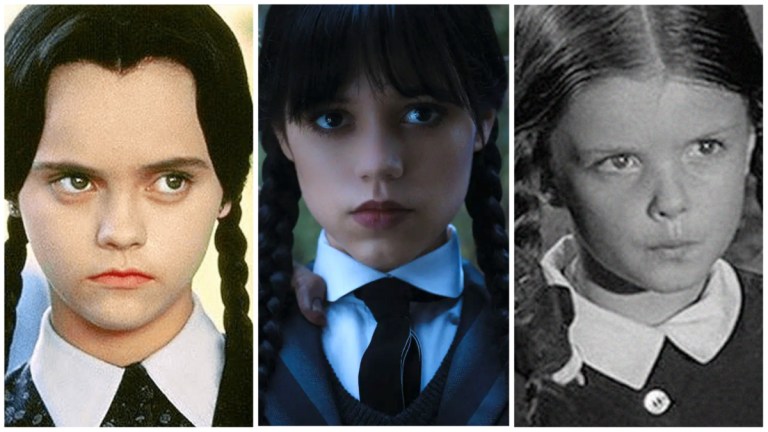
The Addams Family did not originally have names when created by cartoonist Charles Addams. In fact, it’s debatable whether they were even a family in their original appearances in the pages of The New Yorker! This odd bit of trivia is ironic nearly a century later when each of the core Addams Family members are household names. Through movies and television shows, video games and Broadway musicals, the names of Gomez and Morticia, Pugsley and Fester, live on in the minds of nearly every child.
But perhaps none are more pronounced in the popular imagination than Wednesday Addams, Gomez and Morticia’s only daughter and a very, very woeful child. Originally conceived of as a “solemn” youth whose personality was defined by a gloomy yet deceptively sweet disposition, Wednesday evolved into a Goth icon by the end of the 20th century–a feat in large part thanks to The Addams Family movies directed by Barry Sonnenfeld and which starred Christina Ricci as a ruthless and possibly homicidal antihero.
Now, just in time for the holidays, the character is being reinvented again as the star of her very own Netflix series, Wednesday, with rising talent Jenna Ortega reimagining the character in her darkest era yet: high school. From a background presence in the cartoons to the star of her own Netflix drama, it’s been a wicked evolution across almost all forms of media. So join us as we follow the journey of Wednesday’s child.
The Original Charles Addams Cartoons
As mentioned above, Charles Addams did not initially intend for his menagerie of characters and creatures to be an extended family. Indeed, “the Addams Family” began with only one of the characters we now recognize in place: a Gothic, pale beauty, who we’d come to know as Morticia Addams, stands next to a hulking brute that could never possibly be mistaken for Gomez. This pair appears in a 1938 single panel cartoon where an overly optimistic door-to-door salesman attempts to upsell them on a vacuum cleaner.
The real-life Charles Addams had a natural predilection for the macabre, spending much of his childhood happily sneaking into the ruined and abandoned Victorian mansions that littered the New Jersey countryside at the turn of the 20th century. It was an interest in such homes that inspired Charles’ morbid cartoons—and a fixation that he carried all his life, including when even in his later years he liked to picnic with his wife in cemeteries.
The character who would become Wednesday Addams was invented in 1943 as the ghostly looking sister of another child that (eventually) became the schlubby Pugsley. The pair were soon seen placing the girl’s dolls into a tiny guillotine—all the better for beheading. With that said, Wednesday’s early disposition in the cartoons differed from how the character is now perceived by pop culture. She was often drawn smiling, albeit at things conventional tastes would find disturbing. Also unlike the other popular characters in Charles’ collection, Wednesday was the only family member drawn with black almond-shaped eyes, somewhat resembling that of a doll beneath her towering forehead and long braids. All other Addams family members had white eyes with black pupils. This added to her comparatively morose nature.
Still, the devilish streak was there in Charles’ early cartoons. In the above tweet, for instance, you’ll find the characters we now call Gomez and Morticia telling a babysitter, “We won’t be late, Miss Weems. Get the children to bed around eight, and keep your back to the wall at all times.” Behind the blandly cheerful babysitter, the characters of Wednesday and Pugsley are watching their new charge, Pugsley with a devious smile and Wednesday with a blank one.
The amusing joke is that Miss Weems shouldn’t have to worry about Gomez and Morticia’s punctuality—but she should be deathly concerned about the children if she hopes to survive the night. The animated clues suggest Pugsley is more outwardly malevolent, but Wednesday’s bland, innocuous smile seems to belie perhaps a more chilling danger. It’s a seed of what became the enduring image of Wednesday on the screen… eventually.
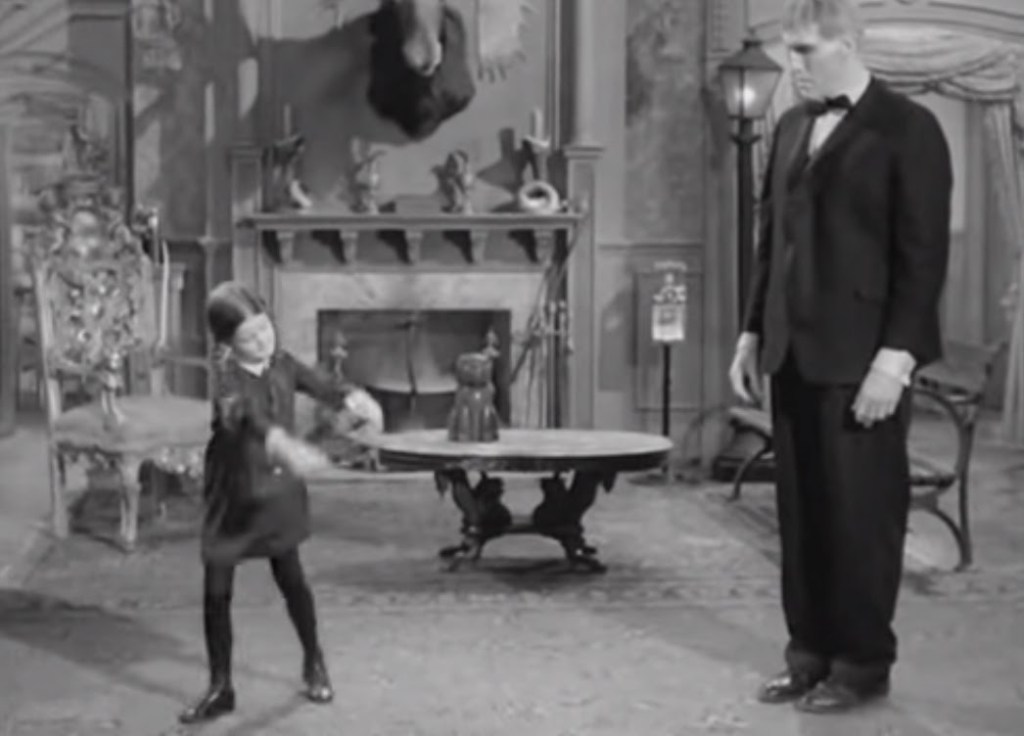
The Addams Family Television Series
It was not until the advent of the ABC television series, The Addams Family, that Charles sat down to name each of the characters and define their personalities. And even then his instincts often ran toward conflict with the values (and censorship) of 1960s American television. Consider the biography that Charles gave television producers for the father character: He suggested they should tease bastardy when he wrote, “Gomez, husband of Morticia, if indeed they are married at all…” That detail, as well as Charles’ original name for the Pugsley character—Pubert—did not make it to the air.
Still, it is this television series that defined much of our understanding of these characters, including the now classic theme song with snapping fingers by Vic Mizzy, which to this day remains a staple of Halloween parties everywhere. It is also where Charles named Wednesday after an old English nursery rhyme that goes back to at least the early 19th century, “Monday’s Child.”
The earliest known published version of “Monday’s Child” appeared in an 1838 issue of Traditions of Devonshire where it had been collected with several other poems by James Orchard Haliwell. And according to Halliwell, it was from a centuries-old tradition to determine a child’s fate based on the day of the week they were born. You can read the full poem below:
“Monday’s child is fair of face,
– English Poem
Tuesday’s child is full of grace,
Wednesday’s child is full of woe,
Thursday’s child has far to go,
Friday’s child is loving and giving,
Saturday’s child works hard for a living.
And the child born on the Sabbath day
Is bonny and blithe, good and gay.”
Beyond the poem, Addams wrote a full mini-bio for the television writers about Wednesday, including the following: “She is a solemn child, prim in dress and on the whole pretty lost. Secretive and imaginative, poetic, seems underprivileged and prone to occasional tantrums. Has six toes on one foot.”
The six toes detail never made it to ABC, and frankly little else did of Charles’ characterization. As played by Lisa Loring, the original live-action Wednesday Addams is a sweet and warm-hearted little girl who occasionally partakes in her New Yorker counterparts’ interest (although on the show she merely lets Pugsley behead her dolls as opposed to doing it herself). But on the whole, she is a happy kid who other than her severe braids and Gothic costuming is interchangeable with the children of most mid-20th century American sitcoms.
In The Addams Family’s pilot, she happily puts on a friendly face while helping a school board superintendent find her father. In another episode, she tries to teach the Frankenstein’s Monster-like Lurch (Ted Cassidy) to be “groovy” by dancing like “a swinger.” Cue a sequence of adorable kids doing the darndest things by dancing like the beatniks.
Entire generations grew up watching Loring and loving her wholesome interpretation of Wednesday, both on ABC or in syndication for decades afterward. And according to Charles Addams, the show maintained the original conceit of the characters reflecting a loving family—just perhaps a more palatable one to middle America. The animator also later said they were now “only half as evil” as in his cartoons.

Christina Ricci Makes Wednesday a Goth Icon
Director Barry Sonnenfeld later admitted to the press that he didn’t watch The Addams Family TV show while growing up in the 1960s. It shows from the very first scene of the 1991 live-action movie that recreates one of Charles Addams’ most infamous cartoons wherein the family gleefully pours boiling oil onto Christmas carolers knocking at their door—as a good natured practical joke, of course.
Sonnenfeld, a visual stylist who was making his directorial debut after being the Coen Brothers’ go-to cinematographer in the 1980s, was cutting his teeth on storytelling dynamics in ’91 when The Addams Family was released. Luckily, he already understood style and aesthetic tone perfectly well. He also knew how to lean into good things with his actors, be it Raul Julia and Anjelica Huston as a far lustier version of Gomez and Morticia, to new discovery Christina Ricci as a deadpan secret weapon in the role of Wednesday.
In terms of design, Ricci and costume designer Ruth Myers returned Wednesday to the “sullen child” note Charles gave TV producers. With sickly pale white skin and a seemingly allergic reaction to smiling, Ricci appeared the very definition of sullen. However, the filmmakers discovered despite only being 10 years old during principal photography, Ricci had a deep reserve of charisma and a devastatingly dry comic delivery. Playwright Paul Rudnick was brought in to do uncredited rewrites on the first Addams Family script and apparently wrote heavily to Ricci’s gift for acerbic brutality.
The first movie is thus a battlefield littered by the bodies of devastating one-liners, all courtesy of pint-sized Wednesday. When she places Pugsley (Jimmy Workman) into an electric chair, he asks what game they are going to play? Her immediate response: “It’s called ‘Is There a God?’” And when the film’s villains fall into open graves among the Addams’ cemetery during the movie’s climax, her brother wonders aloud, “Are they dead?” Picking up a shovel, Wednesday indifferently turns her head to respond, “Does it matter?” And that, as they say, is the end of that!
To the films’ credit, the performances and characters never forget the real trick of the Addams being loving family members who dote on one another. There is no sense of heated conflict among them; it’s just their idea of expressing love or enjoying life is intentionally bizarre to the American mainstream… it can also be faintly sinister. The Sonnenfeld movies remembered this where the ‘60s television show did not, and in the case of Wednesday heightened it. In the process, they created an alt-girl icon for little Goth millennials everywhere to admire and emulate.
This became even more pronounced in Addams Family Values (1993), one of the few comedy sequels generally considered superior to the original. And a large part of that is because Ricci is elevated to one of the leads of the film by returning (and now credited) screenwriter Rudnick. Wednesday’s plot line involves her and Puglsey being sent (condemned, really) to summer camp. There Wednesday is finally forced to deal clear-eyed and soberly with blonde, Disney-fed WASPs who are blatantly said to be all the children of the wealthy elite.
When they try to force Wednesday to conform by trapping her in bungalows that play Disney movies and Annie all day, it’s a form of psychological torture on the poor girl. So when she gets her eventual revenge on them, it’s both thrilling and perhaps even a little perverse for a family movie. In the climax, Wednesday has her mean girl rival tied to a stake and doused in gasoline. Wednesday then at last gives these preppy kids her first genuine smile all summer as she lights a match, grinning at her victim as the Addams Family theme song begins snapping and… the film cuts away. Until the very end, it’s left up to the viewer to imagine what happens next.
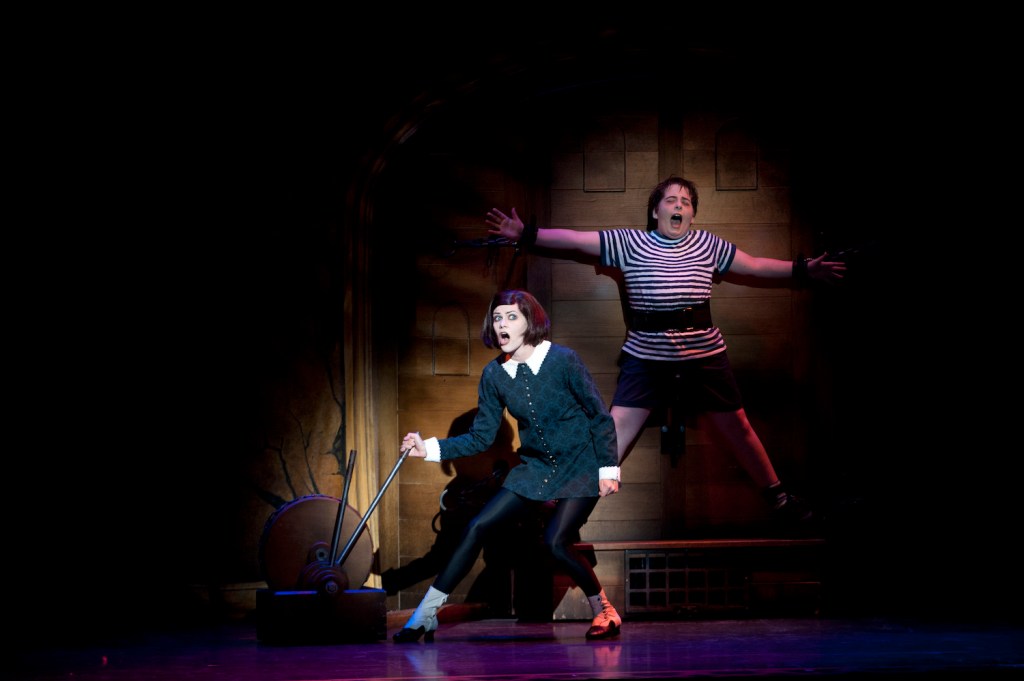
The Addams Family Broadway Musical
There were several other TV and direct-to-video versions of The Addams Family in the late ‘90s, but the next major one in pop culture came from the stage…
The Addams Family musical was a disappointment for producers when it opened on Broadway in 2010. Despite starring legends Nathan Lane and Bebe Neuwirth as Gomez and Morticia, the notoriously troubled musical had changed directors between its Chicago “try-outs” and its Broadway opening; this did not save it from the eviscerating reviews of the New York press. The show went on to run for “only” 722 performances (a little under two years). While not a disaster, it was not the decade-spanning run producers look for when adapting popular intellectual property.
Nonetheless, the show’s writers Marshall Brickman and Rick Elice, who worked from songs with music and lyrics by Andrew Lippa, continued to tinker with the show on tour and that’s the version which discovered an unlikely second life as the most popular musical for high schools and regional theaters in the 2010s. Indeed, many younger Gen-Z fans became familiar with the Addams because of putting this show on in their schools’ theater departments. They were also introduced to a different kind of Wednesday.
As originally portrayed by Krysta Rodriguez, the musical’s Wednesday marks a major departure, right down to the absence of her trademark braids. This was done, in part, because the producers aged Wednesday up to her early 20s and felt braids would look inappropriate on a young woman. The change was also likely made because the creators elected to retread the plot of plays like You Can’t Take It With You and La Cage aux Folles: a “normal” young adult brings home his/her significant other from college and asks his/her “strange” parents to act “normal.”
And that is basically Wednesday’s function in the musical. Her first big ballad, “Pulled,” even not-so-subtly namechecks the then highly popular Glee television series while Wednesday belts she’s being pulled in a “new direction” and wants to be normal. She sings to birds and dreams about settling down. She even belts, “Puppy dogs with droopy faces / unicorns with dancing mice / sunrises in wide open spaces / DisneyWorld—I’ll go there twice!”
To Rodriguez’s credit, she fully committed to the gloomy and morose disposition of Wednesday Addams in early scenes, especially during the initial Chicago version of the musical directed with a more insidious aesthetic by Julian Crouch and Phelim McDermott… but those directors were fired in favor of making the show more mawkish and blandly insipid under the watch of Jerry Zaks. Yet however it’s framed, the writing of Wednesday borders on character assassination. Ricci’s interpretation slow-roasted camp counselors over an open fire after they forced her to watch Disney movies. Imagine what she’d do to writers who suggested she would turn out to be a Disney Adult?!
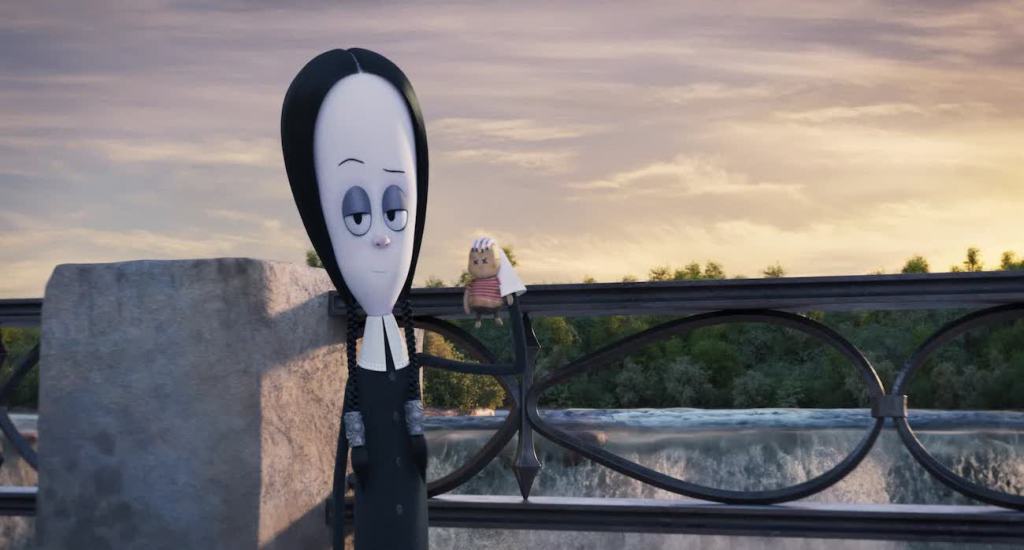
The 21st Century Animated Movies
Wednesday returned to the big screen again in a big way via MGM’s pair of animated films, The Addams Family (2019) and The Addams Family 2 (2021). And this time directors Conrad Vernon and Greg Tiernan even attempt to return the characters’ animated designs to the original Charles Addams drawings.
Hence these movies’ Wednesday (voiced by Chloë Grace Moretz) has an overly large forehead and in the first film keeps her braids in the shape of nooses. This version of the character also attempts to somewhat pivot back to Charles’ earliest designs by generally foregoing the devastatingly mean deadpan that Ricci and screenwriter Rudnick infused in the character. Rather this animated Wednesday is more monotone and wistful, favoring a general ennui over sadism.
It’s a fair reinterpretation of the character, although both films suffer from a lack of imagination, relying on most of the modern lazy animated movie clichés—an emphasis on pop culture references, pop music, and stunt celebrity voice casting (including Moretz), in lieu of sharp writing. Also while Wednesday is the key of both animated movies, she seems decidedly un-Addams like with her desire to wear pink in the first movie and, perhaps more strangely, being eager to prove that she is not an Addams in the sequel but was really switched at birth. Now she hopes she’s the daughter of some Elon Musk-like tech billionaire.
Is it a betrayal of the Addams concept where the ghoulish family is also supposed to be lovey-dovey to each other? A little bit, but the movies are so flatly written and undercooked that it mostly suggests a lack of care in handling details like character motivation and narrative arcs.
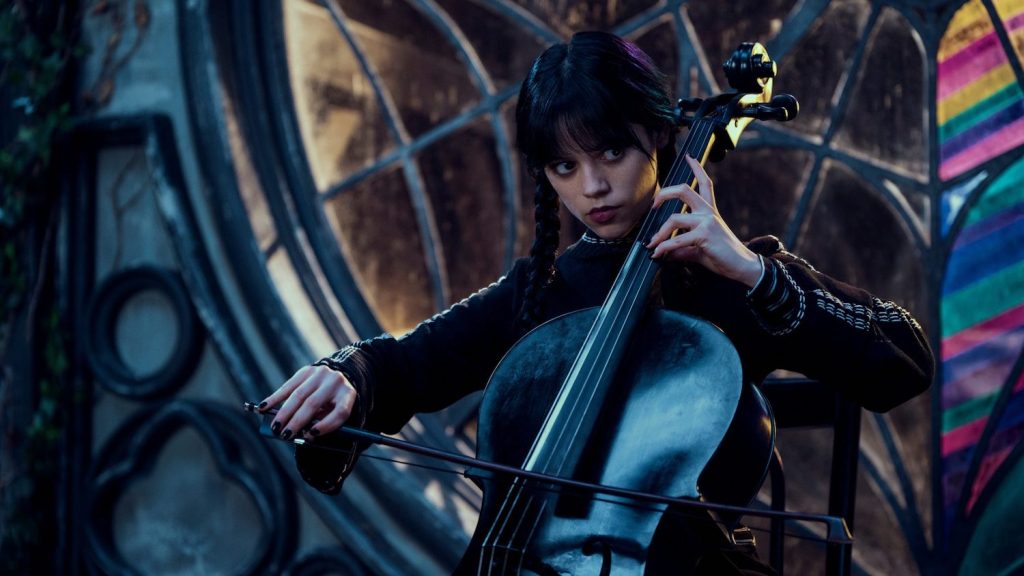
Jenna Ortega’s Wednesday on Netflix
“I act as if I don’t care if people dislike me,” Jenna Ortega’s now teenaged Wednesday says in voiceover narration during the first episode of the series. “But deep down… I actually enjoy it.” Hit Young Adult shows have started from less.
Instead of trying to run from it, Wednesday is the first major adaptation since the ‘90s to lean into Christina Ricci’s legacy with the character—an adult Ricci even appears in a pivotal role on the new Netflix series. However, Ortega and the show also make The Addams Family their own. Now depicted as 16 years old and in the throes of teenage rebellion, Ortega’s Wednesday is harshly sardonic and often cruel in her deadpan bombshells, and she is consciously using it as a weapon to navigate her greatest challenge yet: high school.
In the first scene of the new series, Wednesday is seen punishing jocks who bullied her brother by dropping piranhas into their swimming pool. It’s the only time she smiles in that episode. However, the character is simultaneously less over-the-top than Ricci’s version. As the main character of a TV series, as opposed to one piece of an ensemble in a single-panel cartoon or film, this Wednesday reveals more nuances and dimensionality between the one-liners. Mostly relying on nonverbal cues and flittered glances in Ortega’s piercing eyes, she does care what people think of her—even if she wishes it to be disdain in most cases.
Also like other 21st century versions, this Wednesday is in rebellion with her parents, however not because she is ashamed of them; it’s because she has a borderline narcissistic need to be better than them and is, indeed, revealed to study attributes generally attributed to Gomez and Morticia in other media, including fencing and a passion for the romantic languages like Italian, French, and Spanish—as Wednesday notes, she course studies Italian; it’s the language of Machiavelli! (She also shows some genuine moments of warmth toward Uncle Fester and Thing, the handsy family pet.)
It’s worth noting Ortega is also the first onscreen Wednesday to be played by a Latina actor, which brings to the fore an aspect of the characters that’s been generally downplayed ever since Gomez received a Latin name in 1964.
Wednesday has only had one season, but Ortega is already drawing a commanding portrait of an adolescent Wednesday who is resourceful, tenacious, and unrelenting. She finds herself pulled into typical YA storylines—murder mysteries, love triangles, a school dance—but as judged by the way Ortega moves on the dance floor, this Wednesday is nonetheless an original that, as one of her erstwhile frenemies confesses, “Never had a single ‘F’ to give.” It feels like a fitting culmination for the character.
